Market Rally, Stumble, As Seasonally Strong Period Begins

Inside This Week’s Bull Bear Report
- Market Rally & Stuble To Start The Quarter
- Another Bear Market Rally Coming?
- How We Are Trading It
- Research Report -Strong Dollar A Risk To Corporate Profits
- Youtube – Why Buy Bonds?
- Stock Of The Week
- Daily Commentary Bits
- Market Statistics
- Stock Screens
- Portfolio Trades This Week
Market Rally & Stumble To Start The Quarter
The week started out with a bang, with a market rally of more than 6% in two days. Such was impressive, given the dismal performance in September. However, a stronger-than-expected employment report on Friday crushed the optimism as the focus returns to a more aggressive Fed, increasing the probability of a 4th rate hike of 0.75% this year.
Next week is another opportunity for the bulls as we get the August inflation report. Current expectations are for a 0.1% Consumer Price Index (CPI) increase. Notably, that will be compared to a 0.4% increase in 2021. Moving forward, the annual comparisons become more challenging at 0.9%, 0.7%, 0.6%, 0.6%, 0.8%, and 1.2% through March of 2023. In August, the inflation will drop to 7.9% from 9% in June, and if we assume an average 0.2% monthly increase in the index, CPI will hit the Fed’s 2% target in June 2023.
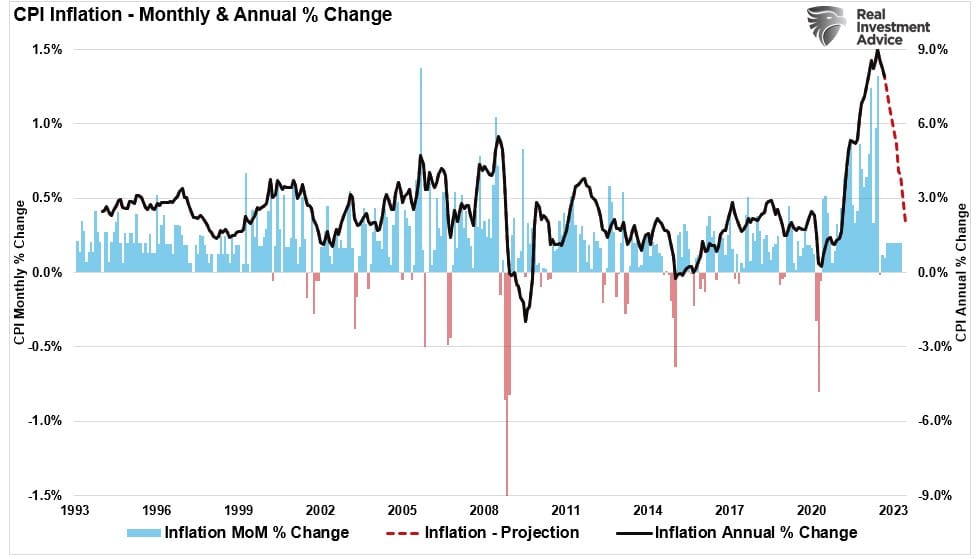
While the market started out the week strong and triggered a MACD “buy signal,” Friday’s selloff was brutal. As shown, the MACD signal remains intact but was weakened considerably, and the market is approaching short-term oversold conditions. I suspect we could see additional selling Monday morning as investors witness their account balances over the weekend and pre-load “sell orders” for the market open.
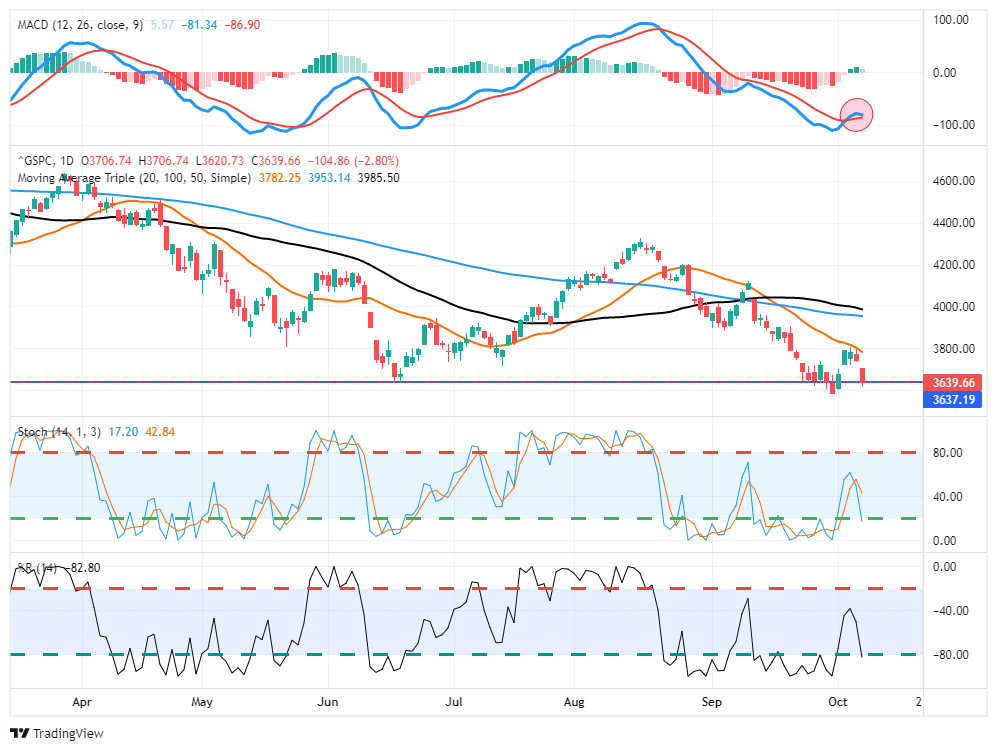
While there was a lot of volatility this week, the market did finish the week in positive territory. As shown in the WEEKLY chart below, the deeply oversold indicators turned up and are close to triggering “buy signals.” The market is also trading 2-standard deviations below the 50-week moving average.
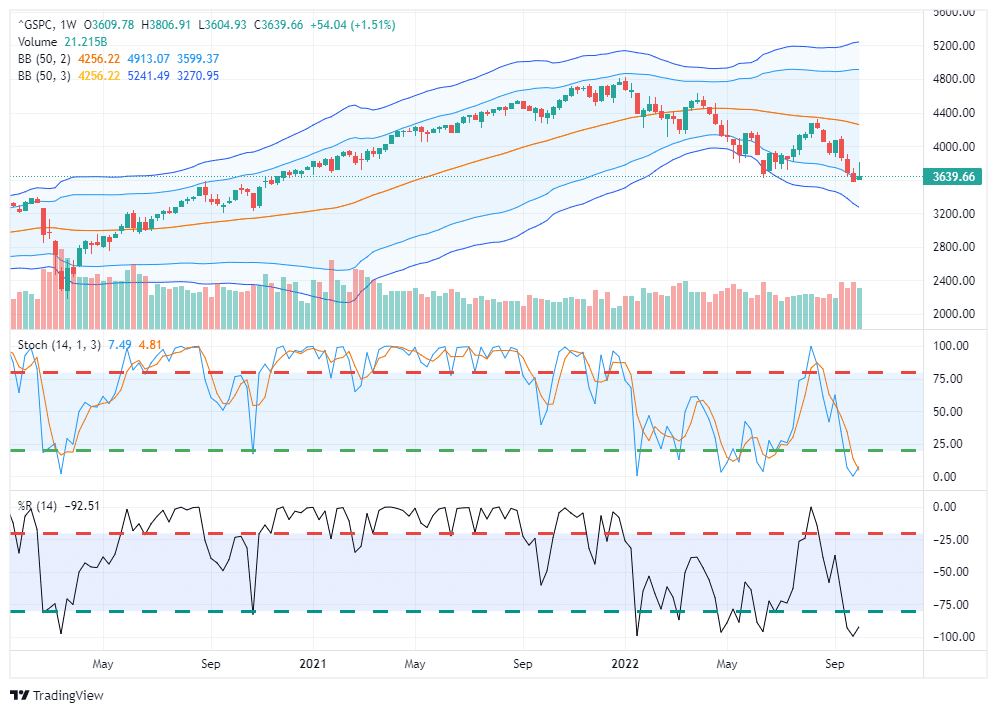
There is certainly downside risk, as we remain concerned the Fed is making a policy mistake by continuing to hike rates. Furthermore, the risk of a recession is increasing, which will slow earnings growth, as we will discuss momentarily. Such is a bad combination for stock prices as we head into 2023. However, given the deep oversold weekly conditions, we continue to suspect a reflexive rally to liquidate positions is likely.
The big question is whether another “bear market” rally is coming.
Need Help With Your Investing Strategy?
Are you looking for complete financial, insurance, and estate planning? Need a risk-managed portfolio management strategy to grow and protect your savings? Whatever your needs are, we are here to help.

Another Bear Market Rally Coming?
In May and June, everyone was so bearish about the market we noted that such was a bullish setup for the market. The market subsequently rallied nearly 17% into August on hopes of a Fed pivot.
Of course, shortly thereafter, Jerome Powell crushed any hope of a more dovish stance on Fed policy, sending stocks to the year’s lowest levels.
So, is another reflexive rally in the offing? The honest answer is I don’t know. No one does. However, there are some valid reasons to suspect such may be the case. However, let’s first determine if the market rally early this past week has some “legs” in the short term.
On Tuesday, September 27th, our email subscribers received our report on why a “Big Short Squeeze” was coming.
In that article, our reasoning for a market rally was that, once again, investor sentiment became so bearish it was bullish. To wit:
“Currently, everyone is once again bearish. CNBC is again streaming ‘Markets In Turmoil’ banners, and individuals are running for cover. Our composite investor sentiment index is back to near ‘Financial Crisis’ lows.”
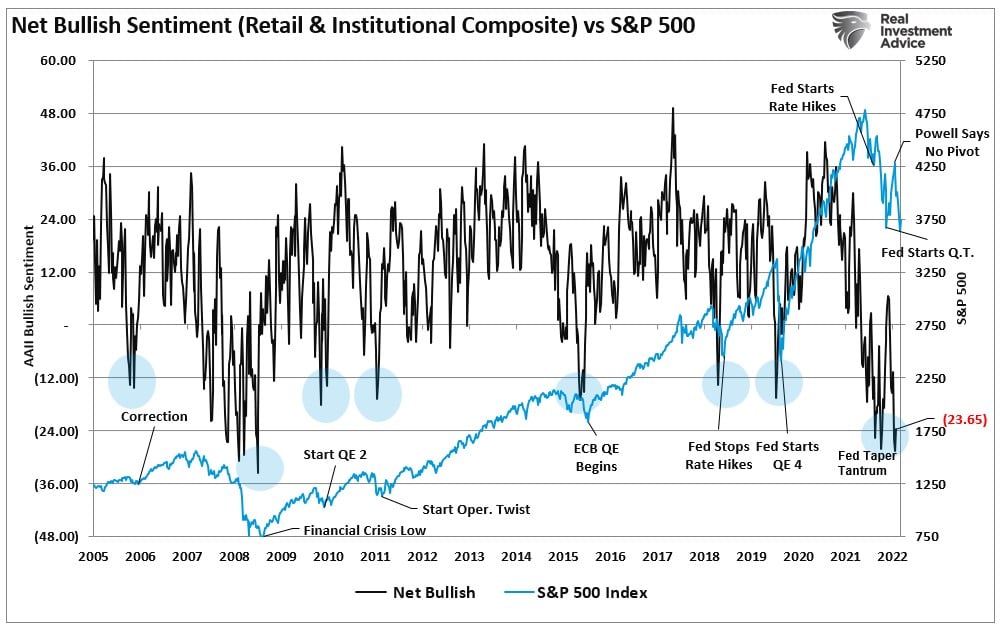
As Bob Farrell’s Rule #9 states:
“When all the experts and forecasts agree – something else is going to happen.
As a contrarian investor, excesses get built when everyone is on the same side of the trade. It is at those extremes that a market reversal tends to occur.
As we finished Q3, with September being one of the worst performance months in several years, everyone became bearish. Not just in terms of “investor sentiment,” as noted above, but also in “positioning.” One of the better measures of professional managers is the NAAIM index. As shown, professional investors are at some of the more bearish levels of exposure. Notably, when the 4-week average of exposure falls below 40, such typically coincides with market bottoms.
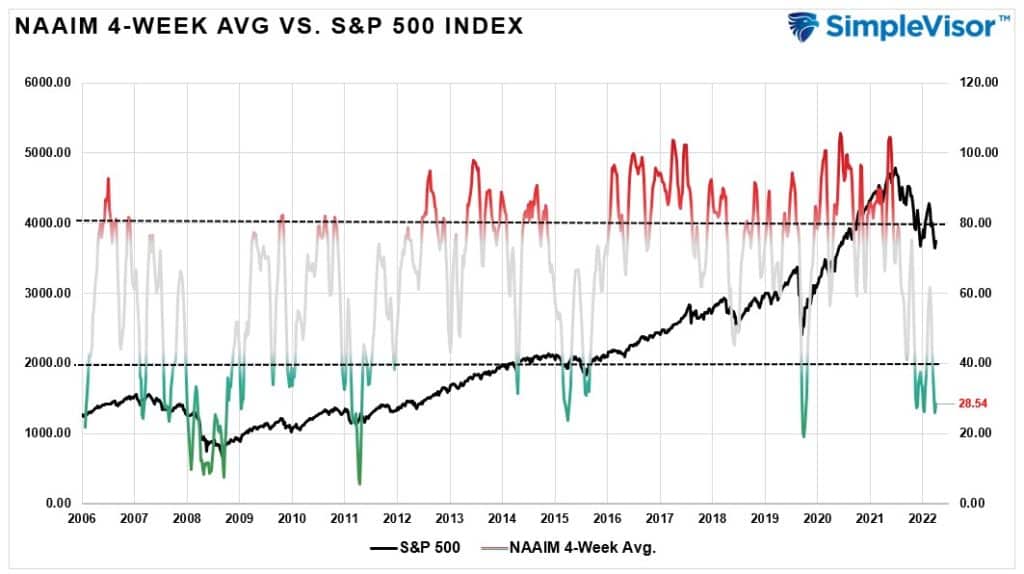
While we reviewed those indicators before this week’s market rally and stumble, are there other confirming indicators suggesting a reflexive rally is possible?
Other Indicators To Watch
Other indicators are also flashing signals supportive of a market rally. We previously noted the CBOE put-call ratio and the low number of stocks on bullish buy signals. Another good contrarian signal remains our weekly Technical Composite Gauge which combines several primary technical indicators into a single weekly composite index. Last week, that index pegged extremely low levels suggesting a “technical washout” in the market.
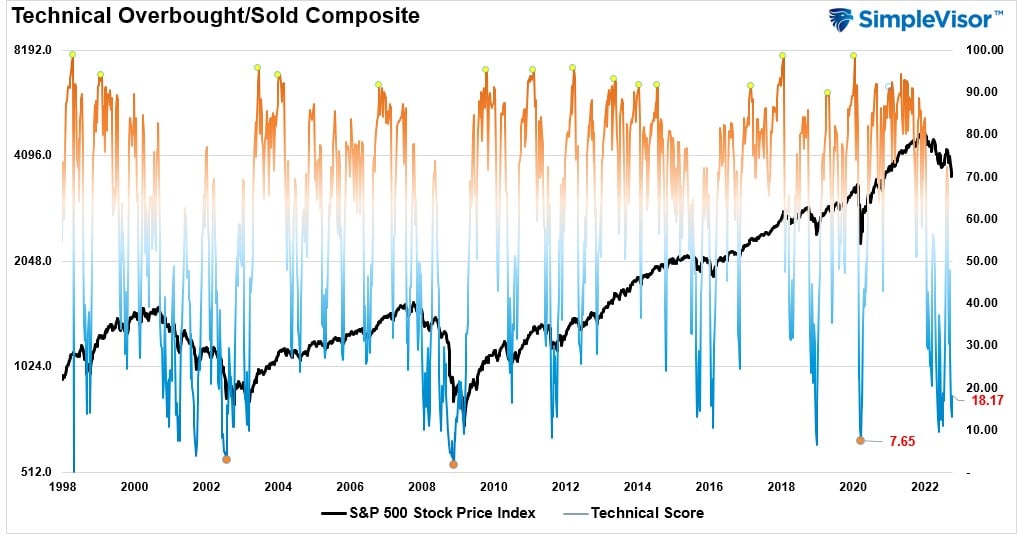
Another good contrarian signal is when retail investors start selling in earnest. As noted by TheMarketEar on Thursday:
“The last two weeks represented the worst selling in single stocks since March 2020. This bearish sentiment was also evident in the options market. Retail traders sold -$1.0B of delta.”
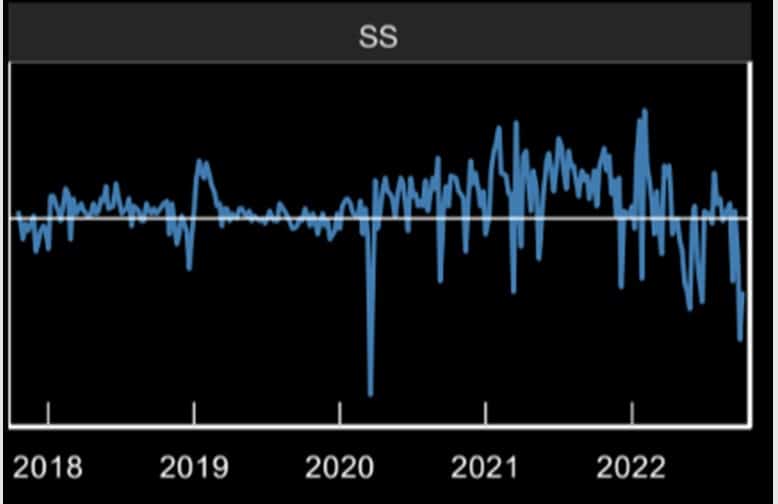
Lastly, as noted by Simon White vis Bloomberg, there are bullish catalysts supportive of a reflexive market rally. To wit:
“But bear-market rallies are rarely about fundamentals (to begin with at least). They are responses to very oversold conditions, the resolution of which is an often-sharp upward move in price.
One way of measuring the magnitude of the bounce off the lows is with a Thrust Signal. It is one of the most reliable buy signals, and one apparently favored by Paul Tudor Jones.
It triggers whenever the net number of stocks rising on the NYSE very quickly goes from being very weak to very strong. Often when you get such a “thrust,” there is a follow-through move over the next weeks or months.”
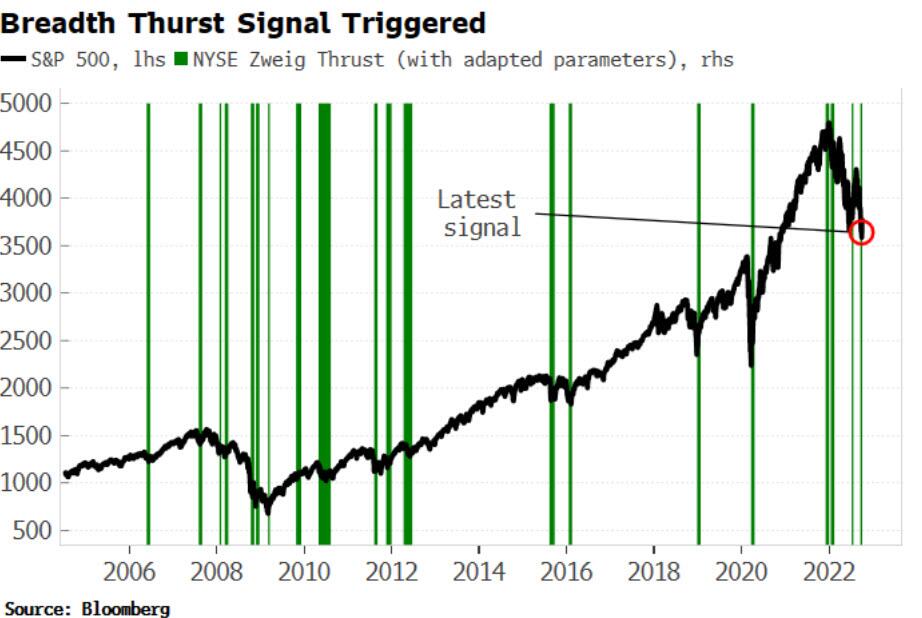
As Simon correctly concludes:
“There are plenty of reasons – from earnings to liquidity to a strong dollar – to distrust a move higher in equities. Despite this though, the thrust signal is telling us the current set-up is an excellent risk-reward opportunity for a potent bear-market rally.”
We agree, which is why we suspect this market rally remains another “opportunity to sell stocks” as the Fed remains on the offense of fighting inflation.
Earnings Remain The Key Risk
The big risk in Q4 remains earnings.
The Fed’s inflation-fighting measures of hiking rates and reducing its balance sheet do not support a market bottom. Why market participants are expecting “this time to be different” is a bit beyond my ability to rationalize.
Such is particularly the case as we head into earnings season. We previously noted the high correlation between the ISM Manufacturing Index and corporate earnings. With the latest release of the ISM Index, the economic backdrop continues to deteriorate, suggesting earnings growth rates will decline further.
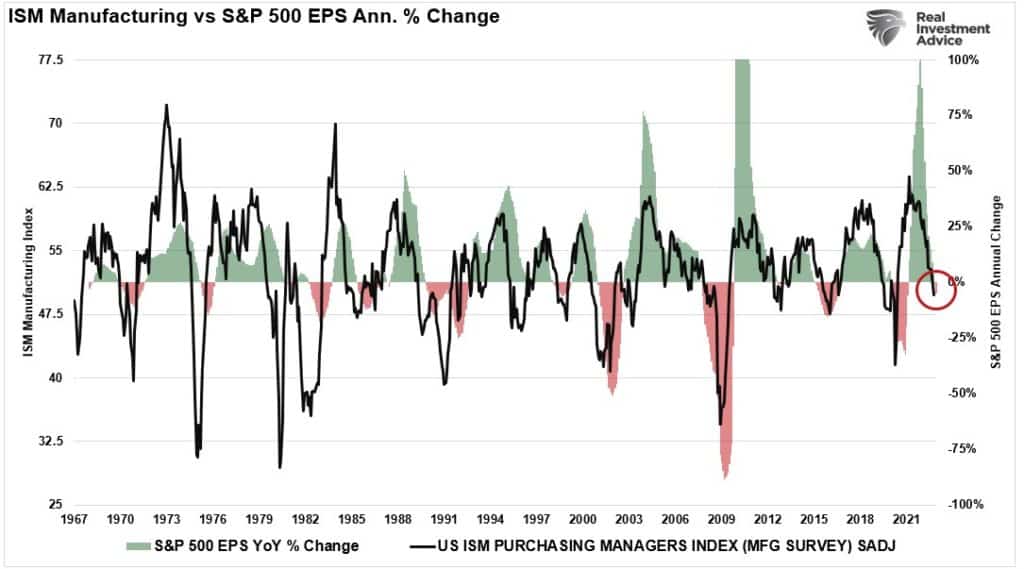
If such is the case, asset prices must adjust lower to accommodate weaker earnings.
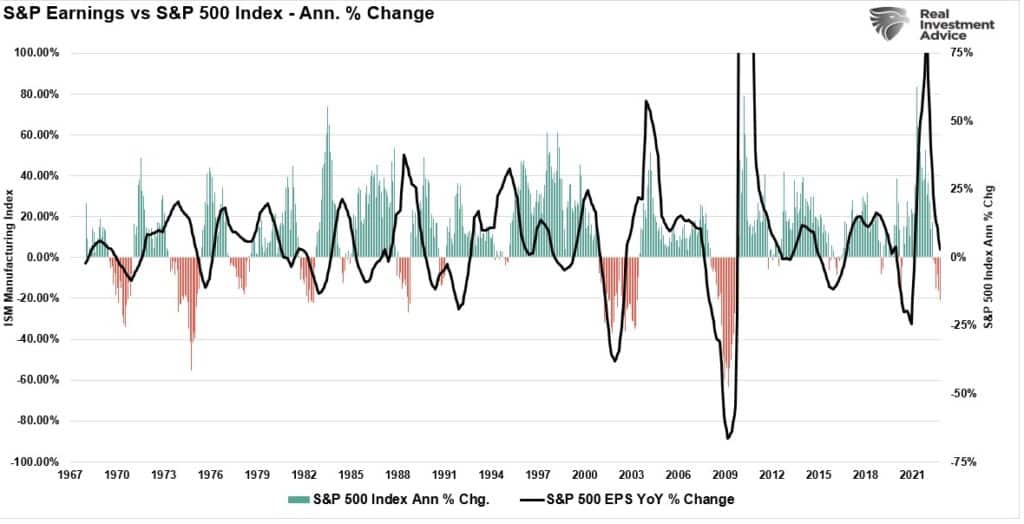
The importance of the analysis is that as the Fed hikes interest rates to reduce economic activity, such also means that earnings growth must also slow. Historically, earnings do not survive rate hiking campaigns.
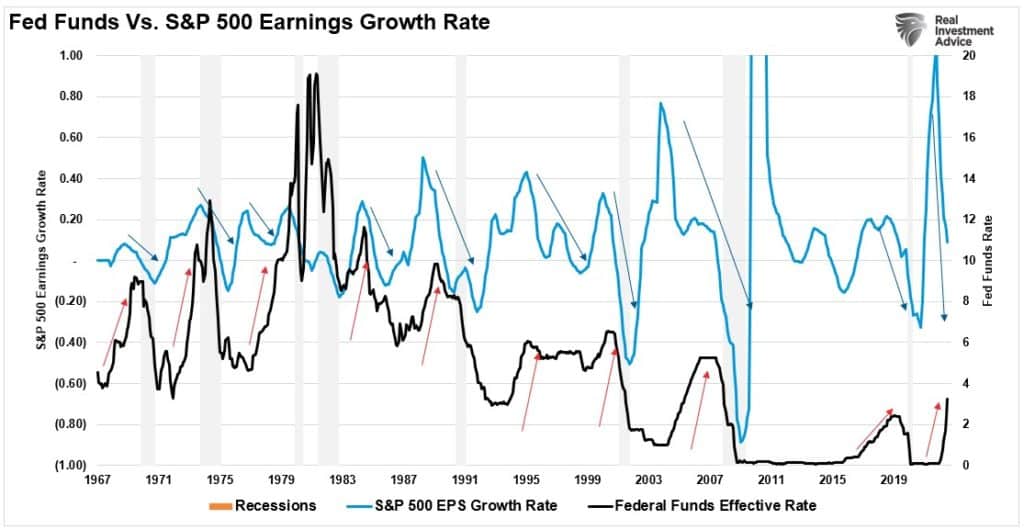
I don’t disagree with the notion that markets could, and possibly will, fall further in the coming months as the Fed likely makes another “policy mistake.” We have spilled much digital ink, suggesting the same. However, that longer-term diagnosis does not preclude a strong “short squeeze” that investors can use to rebalance risks.
We showed previously the 2008 analog the markets continue to follow this year. While we are not suggesting the next “Lehman moment” is about to arrive, the lesson is that even during bear markets, there are market rallies that can be sold into.
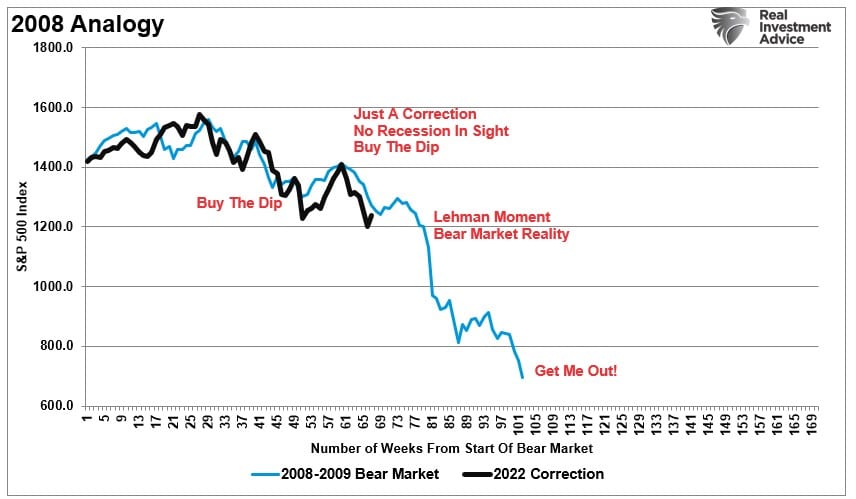
If the analog continues to hold up, we could see another rally before the next decline.
Let’s review the rules to navigate the market rally over the next few weeks.
Not Getting The Bull Bear Report Each Week In Your Mailbox? Subscribe Here For Free.
How We Are Trading It
As noted last week, the Fed funds futures market has priced in the Fed’s likely “terminal rate” on monetary policy going into 2023. We moved our cash holdings into short-term treasuries as we see no near-term catalysts to deploy that cash into equities.
However, given the market’s deeply oversold conditions, we did add some equity exposure this past week for the expected reflexive market rally. Our trades are posted at the bottom of this report. These are short-term additions, and given that we think downside risk remains, we will use any short-term rally to reduce equity risk further, add hedges, and reduce overall risk.
We will also be doing some tax loss harvesting over the next few weeks as we move into year-end. That process will also raise additional cash in portfolios.
Despite the modest equity increase, we remain underweight in stocks and bonds and overweight cash and short-term Treasuries. (The ETF allocation comprises short-duration Treasury bonds and floating rate Treasuries, with a lesser allocation to long-dated Treasuries. You can view our models in real-time at SimpleVisor.com)

Navigating The Market Rally
Here are the guidelines to use during the next market rally.
- Move slowly. There is no rush to make dramatic changes. Doing anything in a moment of “panic” tends to be the wrong thing.
- If you are overweight equities, DO NOT try and fully adjust your portfolio to your target allocation in one move. Again, after significant declines, individuals feel like they “must” do something. Think logically about where you want to be and use the rally to adjust to that level.
- Begin by selling laggards and losers. These positions were dragging on performance as the market rose, and they led on the way down.
- Add to sectors, or positions, that are performing with or outperforming the broader market if you need some risk exposure.
- Move “stop-loss” levels up to recent lows for each position. Managing a portfolio without “stop-losses” is like driving with your eyes closed.
- Be prepared to sell into the rally and reduce overall portfolio risk. As the rally ensues, you will start to second-guess selling. Avoid that emotional trap and follow through with your plan.
- If none of this makes sense to you, please consider hiring someone to manage your portfolio. It will be worth the additional expense over the long term.
See you next week.
Research Report

Why Buy Bonds – The Primer
Subscribe To Our Youtube Channel To Get Notified Of All Our Videos
Stock Of The Week In Review
Quality Hiding Places
This week we put our twist on a MarketWatch stock screen offering quality earnings with a high dividend yield. The screen looks at companies in the S&P 500 with relatively lower betas, higher dividend yields, and good prospects for 2024 sales and earnings growth. We take MarketWatch’s top 22 screen results and refine the value criteria to arrive at our five stocks.
As we have noted previously, using our factor tracker, high dividend yield stocks are the best-performing factor YTD. After the recent bounce from new bear market lows, it may be time to start thinking about shelter in case of another leg lower.
Screen Criteria
- 12-Month Beta < 1
- Dividend yield > 3.5%
- 2024 EPS Growth > 4%
- 2024 Sales Growth > 4%
- Forward P/E < 12
Cisco Systems (CSCO)
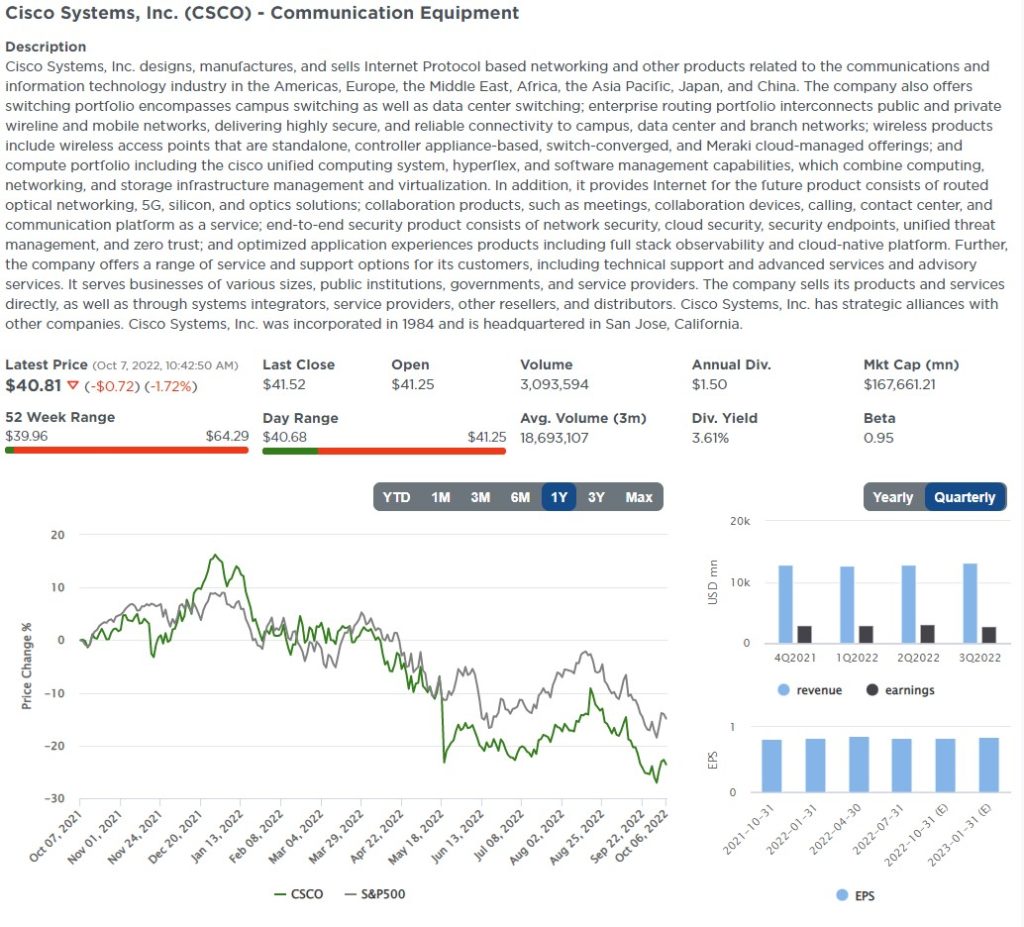
Login to Simplevisor.com to read the full 5-For-Friday report.
Daily Commentary Bits
By the Numbers: Mid-Term Elections + Stock Market
What’s up for grabs: Midterm elections 2022
- All 435 House seats and 35 of the 100 Senate seats (source: Jefferies)
- 36 out of 50 states will elect governors (source: Jefferies)
What stocks tend to do around midterm elections
- Since 1942, the median equity market returns in the first three-quarters of midterm election years were -1%, 2%, and 5%, respectively. 4Q returns jumped to 8%. (Source: U.S. Bank)
- The average annual return of the S&P 500 in the 12 months before a midterm election is 0.3%, below the historical average of 8.1%. (Source: U.S. Bank)
- The S&P 500 has historically outperformed in the 12-month period after a midterm election, with an average return of 16.3%. (Source: U.S. Bank)
- The last time the S&P 500 Index produced negative returns 12 months after a midterm election was 1939 (see Great Depression World War 2). (Source: U.S. Bank)
What Wall Street Is Saying on the Mid-Terms and Stocks
- “Our analysis shows that the economy’s health is much more important than midterm election results.” — U.S. Bank.
- “The higher cost of living and an aggressive rate tightening cycle complicates the voting picture. A lot will depend on voter turnout on the day.” — Jefferies.
- “But irrespective of the result, there’s a consistent market signal in all 19 midterm elections since WWII: The S&P 500 has ALWAYS been higher exactly a year after the vote.” — Deutsche Bank.
“There are myriad unknowns heading into this period, not the least of which is how the midterms will impact the legislating calculus, but we expect movement on the annual defense bill, a federal funding package that could become a Christmas tree carrying numerous ornaments, and possibly a targeted tax bill.” — BTIG
Click Here To Read The Latest Daily Market Commentary (Subscribe For Pre-Market Email)
Bull Bear Report Market Statistics & Screens

SimpleVisor Top & Bottom Performers By Sector
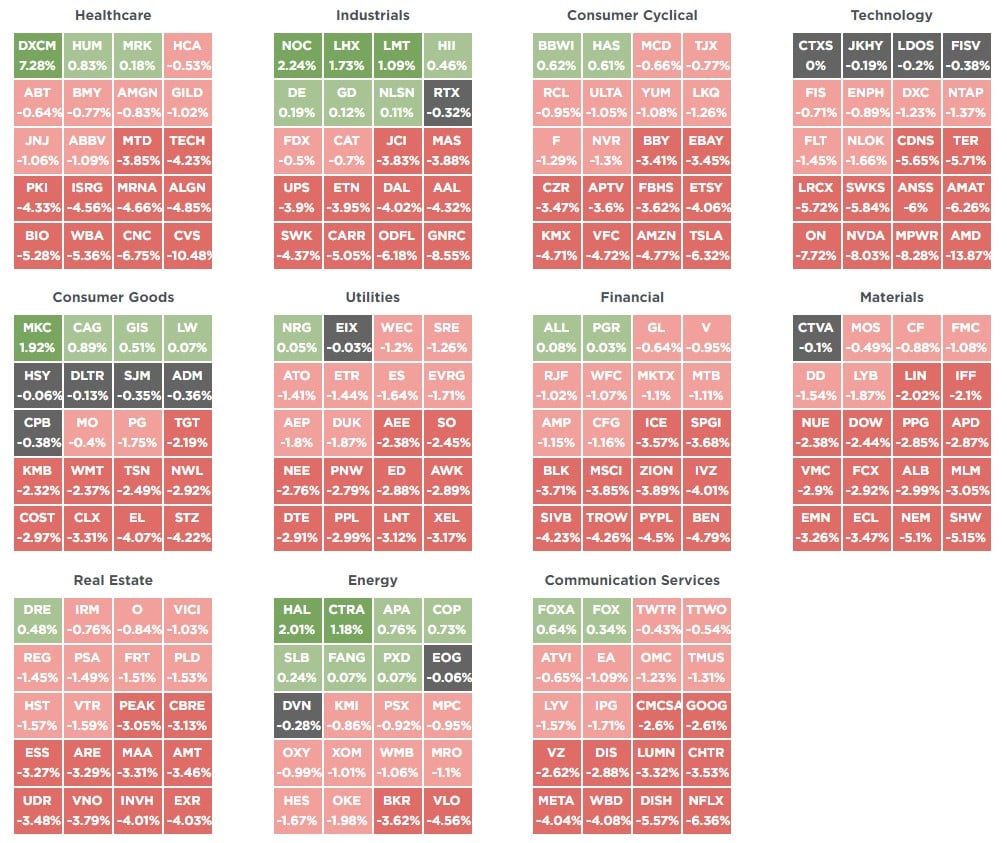
SimpleVisor Asset Class Trend Analysis
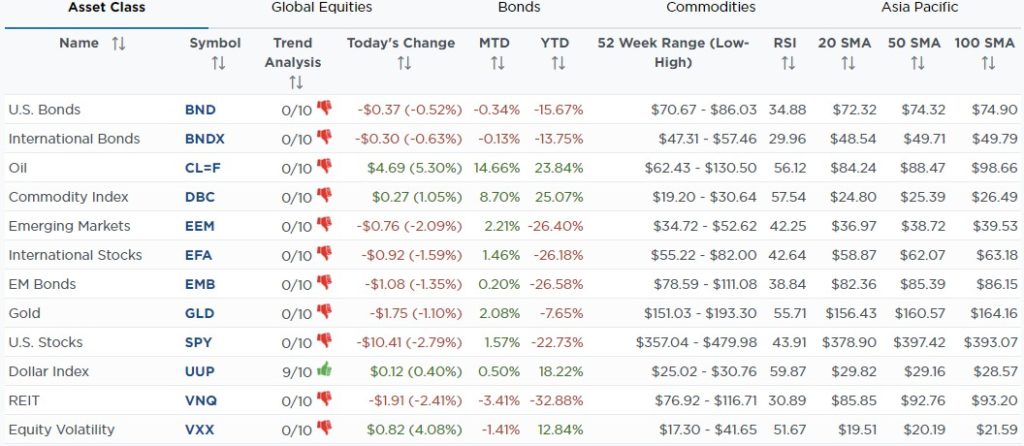
Relative Performance Analysis
The early week rally did lift some sectors out of the extremely oversold conditions, but most, with the exclusion of energy, remain oversold enough for a potential short-term rally. Use rallies to reduce exposure accordingly.
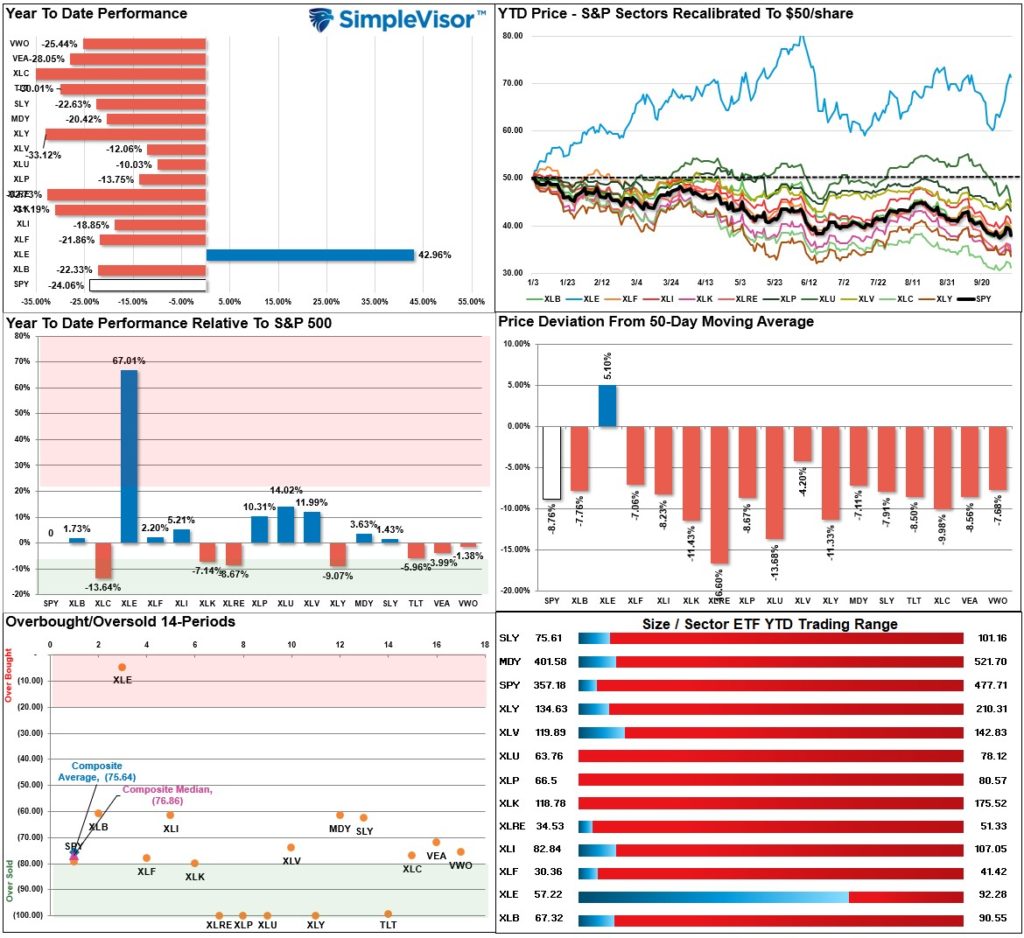
Technical Composite
The technical overbought/sold gauge comprises several price indicators (RSI, Williams %R, etc.), measured using “weekly” closing price data. Readings above “80” are considered overbought, and below “20” are oversold. Markets tend to peak when readings are at 80 or above, which suggests profit-taking and risk management are prudent. The best buying opportunities exist when readings are 20 or below.
The current reading is 18.17 out of a possible 100 and rising. Remain long equities for now.

Portfolio Positioning “Fear / Greed” Gauge
The “Fear/Greed” gauge is how individual and professional investors are “positioning” themselves in the market based on their equity exposure. From a contrarian position, the higher the allocation to equities, to more likely the market is closer to a correction than not. The gauge uses weekly closing data.
NOTE: The Fear/Greed Index measures risk from 0 to 100. It is a rarity that it reaches levels above 90. The current reading is 26.79 out of a possible 100.
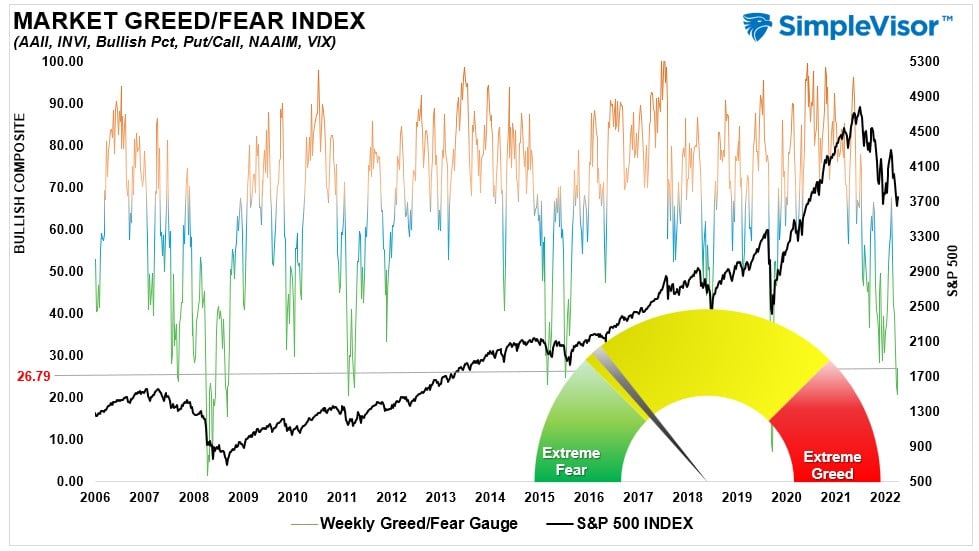
Sector Model Analysis & Risk Ranges
How To Read This Table
- The table compares the relative performance of each sector and market to the S&P 500 index.
- “M/A XVER” is determined by whether the short-term weekly moving average crosses positively or negatively with the long-term weekly moving average.
- The risk range is a function of the month-end closing price and the “beta” of the sector or market. (Ranges reset on the 1st of each month)
- The table shows the price deviation above and below the weekly moving averages.
The selling pressure continued this week, taking almost every sector and market into double-digit deviations below long-term weekly moving averages. Such extremes are not sustainable, and when all markets and sectors are this oversold, a reflexive rally becomes highly probable. Every sector, except Energy, is well below monthly ranges. The Dollar, on the contrary, remains exceptionally overbought. Selling the Dollar to buy Bonds is likely a good hedge trade going into year-end.
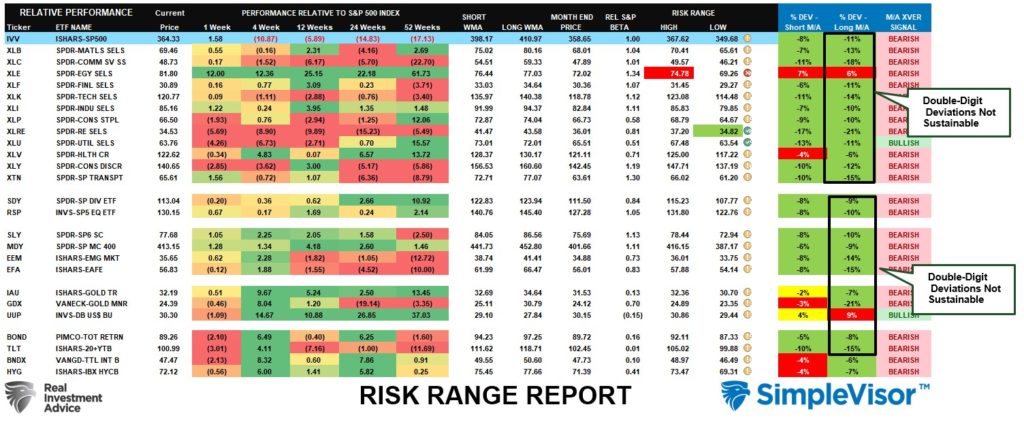
Weekly SimpleVisor Stock Screens
Each week we will provide three different stock screens generated from SimpleVisor: (RIAPro.net subscribers use your current credentials to log in.)
This week we are scanning for the Top 20:
- Relative Strength Stocks
- Momentum Stocks
- Highest Rated Stocks
These screens generate portfolio ideas and serve as the starting point for further research.
(Click Images To Enlarge)
RSI Screen
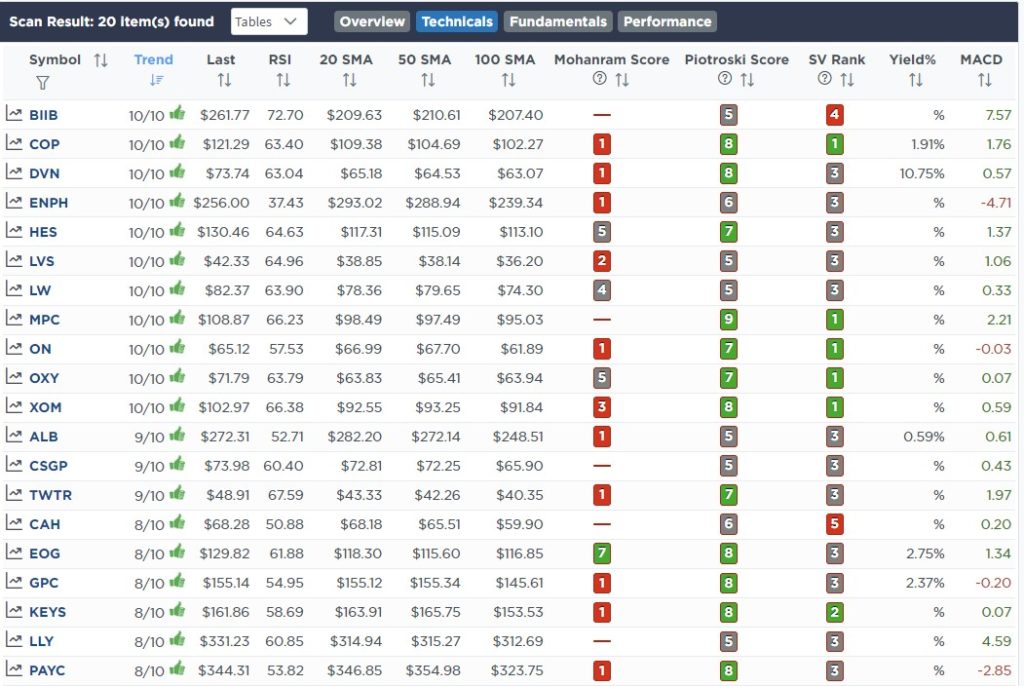
Momentum Screen
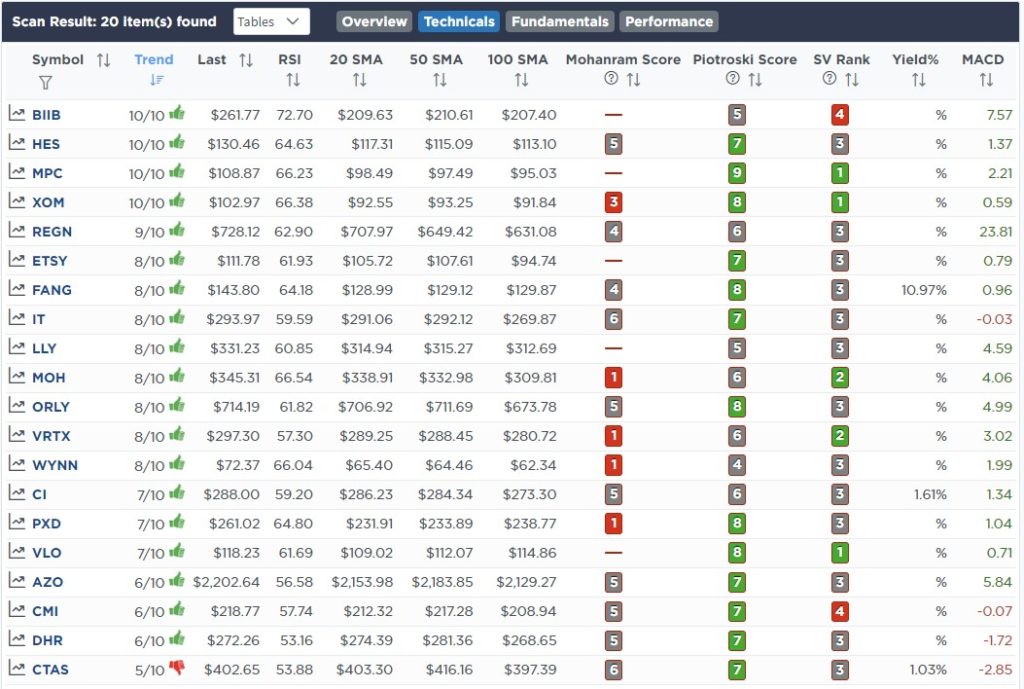
Highest Rated Screen
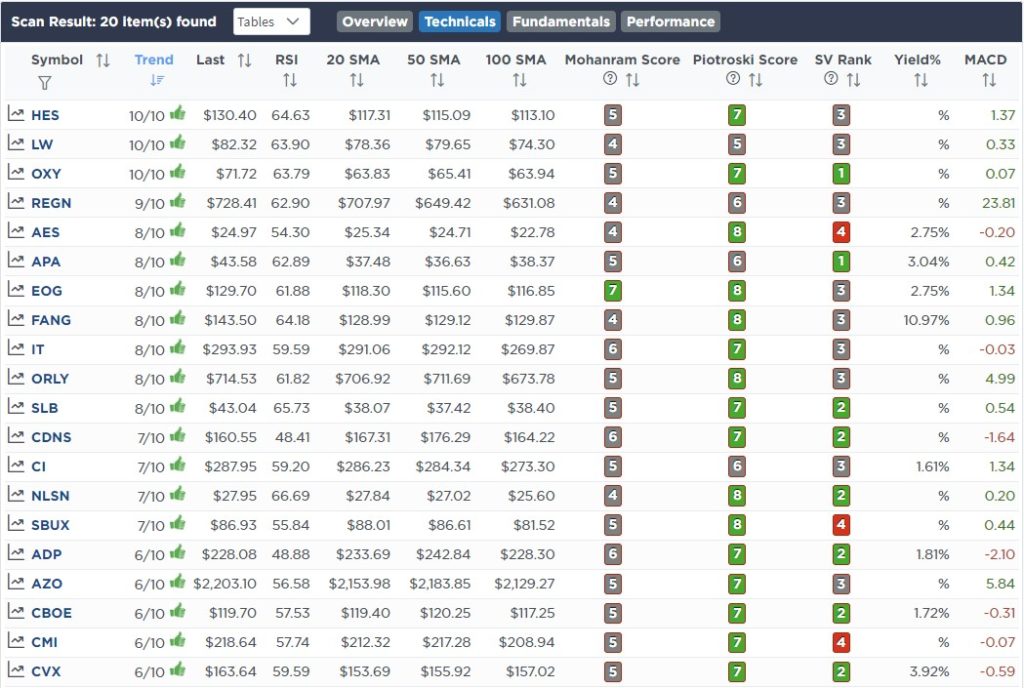
SimpleVisor Portfolio Changes
We post all of our portfolio changes as they occur at SimpleVisor:
October 4th
We have discussed the extremely oversold market condition with a deeply bearish sentiment for the last couple of weeks. Such is a good setup for a “short squeeze” in the markets, and we saw the beginnings of that yesterday with the start of the final quarter. We are adding some exposure to participate in this rally, but as we approach previous downtrend resistance, we will begin reducing that exposure and taking profits. We will likely reduce our total current exposure by more than we added as the rally progresses.
Equity Model
- Add 1% to the Preferred Equity ETF (PFF)
- Add 0.5% to AMZN, NVDA, and AMD for the rally.
ETF Model
- Add 1% to the Preferred Equity ETF (PFF)
- Add 1.5% to the SPDR Technology Sector Index (XLK) for the rally.
October 5th
We added a little more equity exposure to take advantage of what we think will be a decent reflexive rally from very oversold levels. As we said in yesterday’s Trade Alert: We will likely reduce our total current exposure by more than we added as the rally progresses.
Equity Model
- Buy 1% United Healthcare (UNH)
- Buy .5% Google (GOOG)
Sector Model
- Buy 1% Healthcare Sector (XLV)
- Buy .5% Communications (XLC)

Lance Roberts, CIO
Have a great week!





















